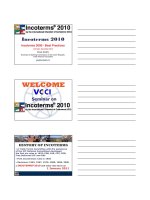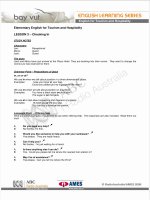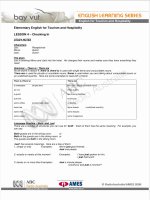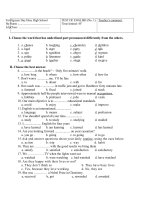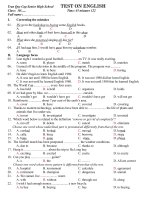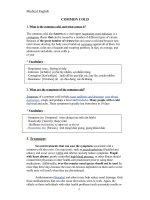ENGLISH 9
Bạn đang xem bản rút gọn của tài liệu. Xem và tải ngay bản đầy đủ của tài liệu tại đây (112.33 KB, 3 trang )
<span class='text_page_counter'>(1)</span><div class='page_container' data-page=1>
<b>UNIT 7. LESSON 3: READ</b>
<b>Period 45</b>
<b>A. OBJECTIVES : </b>
- By the end of the lesson, students will be able to understand the content of the text about
the ways to save energy for both general and specific information.
- Ss know more how North American and European countries save money & natural
resources.
<b>B.TEACHING AIDS:</b>
Lesson plans, Tieng Anh 9, chalk, pictures, projector, computer speaker
<b>C. METHODS:</b>
Network, pre-questions,
<b>D. CONTENTS . </b>
<b>I. Organization</b>
<b>Class Date of teaching Absent Ss</b>
<b>9D1 ……….. ……….</b>
<b>9D2 ……… ………</b>
<b>Teacher & Ss’ activities</b> <b>Content </b>
<b>II. Warm-up: (5’)– brainstorm </b>
- Work in group
- Write their ideas on the board.
<b>- Chatting</b>
What are you interested in when you buy
electrical appliances?
~ price, quality, size, style, power, …
=> lead in the new lesson.
<b>Step 1. Pre-reading (12m)</b>
- Introduce the topic of the passage reading
and some new words to students
<b>Act 1. Pre- teach vocabulary: </b>
- Repeat chorally, individually and guess
its meaning, then copy down.
- Luxury >< Necessity (n)
- cheap and clean
- provides enough power for the world
population
- does not cause pollution
- can be stored for a number of days.
- can be received by the solar panels
installed on the roof of a house.
- can be used on cloudy days.
- help save money as well as natural
resources.
<b>1. Vocab</b>
- Luxury (n) xa xỉ
- Consumer (n): người tiêu dung/ ng tiêu
thụ
- Household (n): hộ gia đình
</div>
<span class='text_page_counter'>(2)</span><div class='page_container' data-page=2>
- Consumer (n): user of product or service
- Household (n): family.
- Account for (v): represent
- Labeling scheme (n): campaign that gives
labels to products.
- Tumble dryer (n): machine that dries
things usually hair or clothes.
- Innovation (n): bringing in new ideas,
making changes.
- to conserve -> conservation (n)
- category (n) (translation)
<b>Check: W-W</b>
- Have students repeat the words in chorus
then rub out word by word but leave the
circle. Remember to let sutdents repeat
before and after rubbing out each word.
- Go on until students can remember the
words.
- Get students to write the words again in
the correct circles.
<b>Step 2: While-reading (17’) </b>
Act 1.Checking:
- Ask Ss to read the passage very quickly
and answer the following questions:
- Read the passage quickly and answer the
questions.
- Call on some Ss to answer the questions.
- Give feedback:
1. America and Europe
2. They are necessities
<b>Act 2- Comprehension questions</b>
- Ss read the passage again to find the
information to answer the questions in
section b-P.61.(pairwork)
-read their answers aloud in front of class.
<i><b>Act 3. Choosing the best summary: </b></i>
+ Which of the following is the best
summary of the passage?
<b>2. Reading</b>
1 America and Europe
2. They are necessities
1. What are Western consumers interested
in?
2. What can they do to spend less on
lighting?
3. Mrs. Jones uses only two ordinary bulbs
and she pays US$ 8 for lighting. How much
will she pay if she uses two energy saving
bulbs instead?
4. What is the purpose of the labeling
scheme?
5. Why should we save energy?
1. Western consumers/They are interested
in products that will not only work
effectively but also save money.
</div>
<span class='text_page_counter'>(3)</span><div class='page_container' data-page=3>
- Have Ss read the passage more carefully
and choose the best summary for it among
four following options
- Ask them to work in groups to find out
the best answer
- Call on some Ss to give explanation for
their choice
- T: asks Ss to give explanations for their
choice.
- T: gives correct answers
<b>Step 3: Post-reading (8’)</b>
Discussion:
Have Ss work in group of 4 Ss to find out
the answers.
<i>1. What should we save energy? </i>
<i>2. What should we do to save money and </i>
<i>natural resources? </i>
- Call on the representative from each
group to present in front of class.
- Give feedback:
<b>IV: Summary: (2’)</b>
How to save energy?
<b>V.Homework (1’)</b>
-Learn by heart new words
- Write a short text telling about how you
do to save electricity.
- Do the exercises ( 6,7 ) in the workbook.
- Prepare for the next lesson Unit 7- Write
3. She will pay US$ 2 for lighting if she
uses energy-saving bulbs instead.
4. The purpose of the labeling scheme is to
help consumers to know how efficient each
model is, compared with other appliances
in the same category so that they
can save money and energy.
5. We should save energy because by saving
energy we can conserve the Earth’s
resources.
<i><b>3. North American and European </b></i>
</div>
<!--links-->
